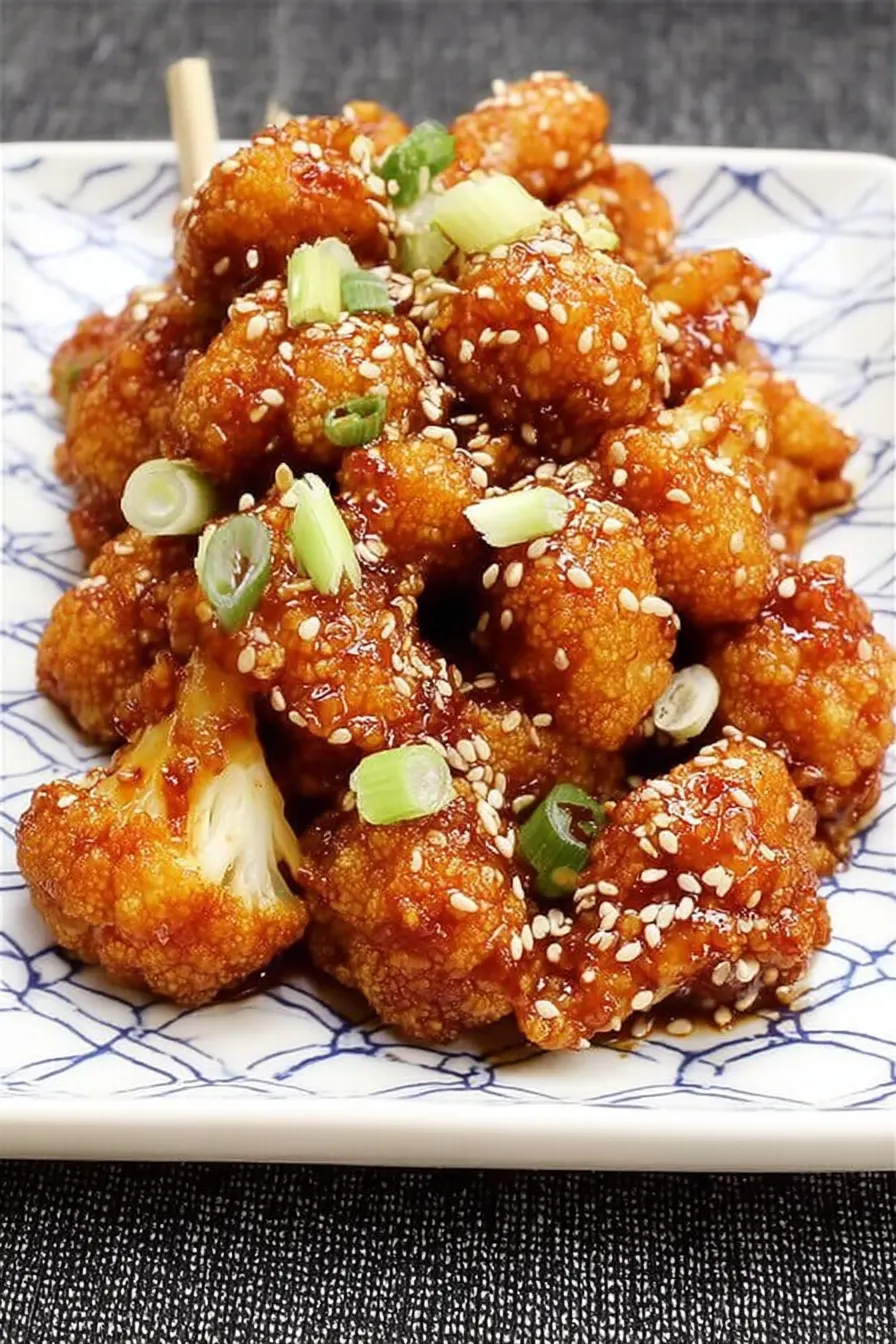I’ve been making this Korean Gochujang Cauliflower for months now, and it never gets old. The combination of crispy battered cauliflower with that sweet, spicy, and tangy gochujang sauce creates something really special. This recipe transforms ordinary cauliflower into a restaurant-quality dish that’ll have you coming back for more.
What I love most about this Korean Gochujang Cauliflower is how it balances flavors. The gochujang brings heat and depth, while maple syrup adds sweetness, and the crispy coating gives you that satisfying crunch. It’s the kind of dish that works as an appetizer, side dish, or even a main course if you’re in the mood for something plant-based.
The beauty of this recipe lies in its simplicity. You don’t need any fancy ingredients or complicated techniques. Most of the sauce ingredients are pantry staples, and the coating process is straightforward. I find that the key is getting the oil temperature right and not rushing the frying process.
Table of Contents
Equipment Needed
- Large mixing bowls (2-3 bowls)
- Deep frying pan or wok
- Wire strainer or slotted spoon
- Paper towels or wire cooling rack
- Measuring cups and spoons
- Whisk
- Tongs or large spoon for mixing
Ingredients Needed
For the Sauce:
- 1-2 tablespoons gochujang (Korean chili paste), adjust to taste
- 1/2 cup room temperature water
- tablespoons maple syrup or liquid sweetener
- 1/3 cup ketchup
- 1 tablespoon soy sauce
- 1 teaspoon rice vinegar or white vinegar
- 2 teaspoons minced garlic
- 1 tablespoon cornstarch
For the Cauliflower:
- 1 pound raw cauliflower florets (from 1 medium head)
- Neutral oil for frying
- Sesame seeds for garnish
- Chopped green onions for garnish
For the Batter:
- 2/3 cup all-purpose flour
- 2 tablespoons cornstarch
- 2 teaspoons baking powder
- 1.5 teaspoons salt
- 1 cup room temperature water
For the Coating:
- 1-2 cups breadcrumbs (adjust as needed)
How to Make Korean Gochujang Cauliflower
- Start by preparing your sauce. In a medium bowl, whisk together the gochujang, water, maple syrup, ketchup, soy sauce, vinegar, minced garlic, and cornstarch until smooth. Taste and adjust the sweetness or spice level to your liking. Set this aside.
- Next, make the batter. In another bowl, combine the flour, cornstarch, baking powder, and salt. Gradually add the room temperature water while whisking until you get a smooth, thick batter. The consistency should coat the back of a spoon but not be too thick.
- Set up your coating station by placing the breadcrumbs in a shallow dish or plate.
- Now comes the fun part – coating the cauliflower. Take each floret and dip it completely in the batter, making sure it’s well coated. Let any excess batter drip off, then immediately roll it in the breadcrumbs. I use one hand for the wet ingredients and one for the dry to keep things clean.
- Press the breadcrumbs firmly onto each piece of cauliflower to help them stick. Place the coated florets on a plate and repeat until all pieces are done.
- Heat about 2 inches of oil in a deep frying pan over medium-high heat. You’ll know the oil is ready when you drop a few breadcrumbs in and they bubble and sizzle immediately.
- Carefully add the cauliflower pieces to the hot oil, but don’t overcrowd the pan. Fry for about 2-3 minutes on each side until golden brown and crispy.
- Remove the fried cauliflower with a slotted spoon and place on paper towels or a wire rack to drain excess oil. Continue frying in batches until all pieces are done.
- Once all the cauliflower is fried, pour out the oil and wipe the pan clean. Return the pan to medium heat and give your sauce another good stir to prevent the cornstarch from settling.
- Pour the sauce into the pan and let it simmer for 2-3 minutes, stirring constantly until it thickens and becomes glossy.
- Here’s where timing matters – add the fried cauliflower to the sauce just before serving. Gently toss to coat each piece evenly. The sauce should cling nicely to the crispy coating.
Helpful Tips for Korean Gochujang Cauliflower
- Don’t add the cauliflower to the sauce too early or it will lose its crispiness. I often only coat half the batch and serve the rest on the side for dipping.
- Test your oil temperature with a few breadcrumbs before adding the cauliflower. The oil should bubble actively but not violently.
- If you can’t find gochujang, you can substitute with sriracha, but the flavor will be different. Gochujang has a deeper, more complex taste.
- For a lighter version, you can bake the coated cauliflower at 350°F for 35-40 minutes, flipping halfway through. Brush with a little oil for better browning.
- The sauce can be made ahead and stored in the refrigerator for up to a week. Just reheat gently before using.
- Cut your cauliflower into similar-sized pieces to ensure even cooking.
Ways to Serve Korean Gochujang Cauliflower
This dish works wonderfully as an appetizer at parties or game day gatherings. The crispy texture and bold flavors make it a crowd-pleaser that disappears quickly.
You can also serve it as a side dish alongside Korean barbecue, fried rice, or noodle dishes. The sweet and spicy flavors complement grilled meats beautifully.
For a complete meal, serve the cauliflower over steamed rice with some pickled vegetables and a simple salad. Add some kimchi on the side for extra Korean flair.
The sauce also makes an excellent dipping sauce for other vegetables like broccoli, Brussels sprouts, or even chicken wings.
Frequently Asked Questions
Can I make this recipe gluten-free? Yes, substitute the all-purpose flour with a gluten-free flour blend and use gluten-free breadcrumbs. Make sure your soy sauce is also gluten-free.
How long does this keep in the refrigerator? The coated cauliflower is best eaten fresh, but leftovers can be stored for 2-3 days. Reheat in the oven at 350°F to restore some crispiness.
Can I use frozen cauliflower? Fresh cauliflower works best for this recipe. Frozen cauliflower tends to be watery and won’t hold the coating as well.
Is there a way to make this less spicy? Start with just 1 tablespoon of gochujang and add more maple syrup to balance the heat. You can always add more spice, but it’s harder to take it away.
Can I prepare the coating ahead of time? The batter and breadcrumb coating can be prepared a few hours ahead, but coat the cauliflower just before frying for the best results.
Print
Korean Gochujang Cauliflower
- Total Time: 40 minutes
- Yield: 4 servings 1x
- Diet: Vegetarian
Ingredients
For the Sauce:
- 1–2 tablespoons gochujang (Korean chili paste), adjust to taste
- 1/2 cup room temperature water
- tablespoons maple syrup or liquid sweetener
- 1/3 cup ketchup
- 1 tablespoon soy sauce
- 1 teaspoon rice vinegar or white vinegar
- 2 teaspoons minced garlic
- 1 tablespoon cornstarch
For the Cauliflower:
- 1 pound raw cauliflower florets (from 1 medium head)
- Neutral oil for frying
- Sesame seeds for garnish
- Chopped green onions for garnish
For the Batter:
- 2/3 cup all-purpose flour
- 2 tablespoons cornstarch
- 2 teaspoons baking powder
- 1.5 teaspoons salt
- 1 cup room temperature water
For the Coating:
- 1–2 cups breadcrumbs (adjust as needed)
Instructions
- Start by preparing your sauce. In a medium bowl, whisk together the gochujang, water, maple syrup, ketchup, soy sauce, vinegar, minced garlic, and cornstarch until smooth. Taste and adjust the sweetness or spice level to your liking. Set this aside.
- Next, make the batter. In another bowl, combine the flour, cornstarch, baking powder, and salt. Gradually add the room temperature water while whisking until you get a smooth, thick batter. The consistency should coat the back of a spoon but not be too thick.
- Set up your coating station by placing the breadcrumbs in a shallow dish or plate.
- Now comes the fun part – coating the cauliflower. Take each floret and dip it completely in the batter, making sure it’s well coated. Let any excess batter drip off, then immediately roll it in the breadcrumbs. I use one hand for the wet ingredients and one for the dry to keep things clean.
- Press the breadcrumbs firmly onto each piece of cauliflower to help them stick. Place the coated florets on a plate and repeat until all pieces are done.
- Heat about 2 inches of oil in a deep frying pan over medium-high heat. You’ll know the oil is ready when you drop a few breadcrumbs in and they bubble and sizzle immediately.
- Carefully add the cauliflower pieces to the hot oil, but don’t overcrowd the pan. Fry for about 2-3 minutes on each side until golden brown and crispy.
- Remove the fried cauliflower with a slotted spoon and place on paper towels or a wire rack to drain excess oil. Continue frying in batches until all pieces are done.
- Once all the cauliflower is fried, pour out the oil and wipe the pan clean. Return the pan to medium heat and give your sauce another good stir to prevent the cornstarch from settling.
- Pour the sauce into the pan and let it simmer for 2-3 minutes, stirring constantly until it thickens and becomes glossy.
- Here’s where timing matters – add the fried cauliflower to the sauce just before serving. Gently toss to coat each piece evenly. The sauce should cling nicely to the crispy coating.
Notes
- Don’t add the cauliflower to the sauce too early or it will lose its crispiness. I often only coat half the batch and serve the rest on the side for dipping.
- Test your oil temperature with a few breadcrumbs before adding the cauliflower. The oil should bubble actively but not violently.
- If you can’t find gochujang, you can substitute with sriracha, but the flavor will be different. Gochujang has a deeper, more complex taste.
- For a lighter version, you can bake the coated cauliflower at 350°F for 35-40 minutes, flipping halfway through. Brush with a little oil for better browning.
- The sauce can be made ahead and stored in the refrigerator for up to a week. Just reheat gently before using.
- Cut your cauliflower into similar-sized pieces to ensure even cooking.
- Prep Time: 15 minutes
- Cook Time: 25 minutes
- Category: Appetizer
- Method: Roasting
- Cuisine: Korean
Nutrition
- Serving Size: 1 cup
- Calories: 170 kcal
- Sugar: 5 g
- Sodium: 540 mg
- Fat: 1 g
- Saturated Fat: 7 g
- Unsaturated Fat: 7 g
- Trans Fat: 0 g
- Carbohydrates: 20 g
- Fiber: 4 g
- Protein: 4 g
- Cholesterol: 0 mg

